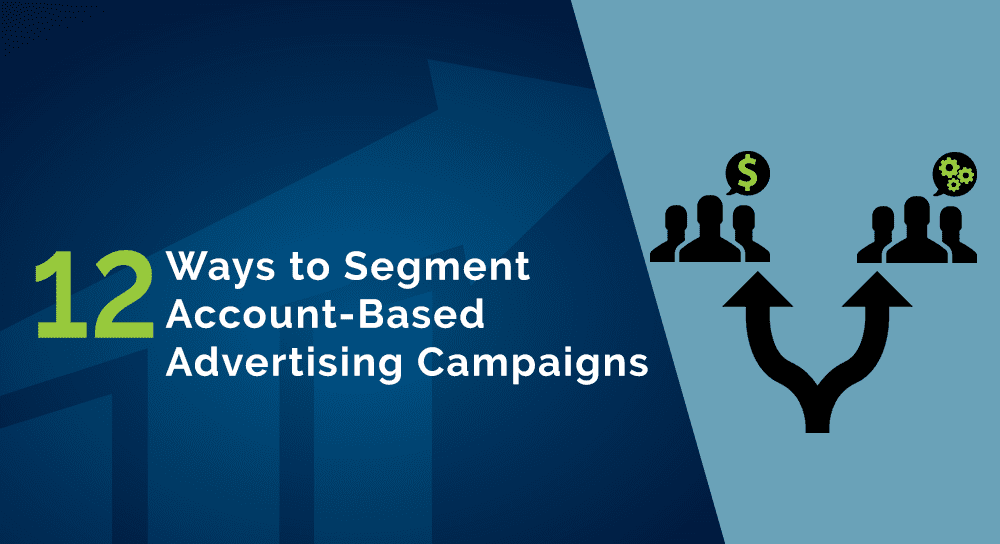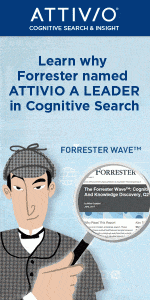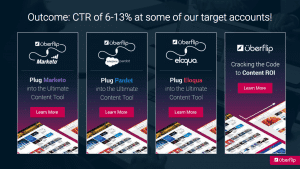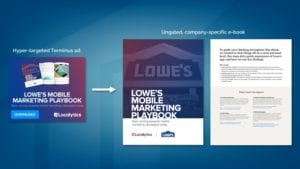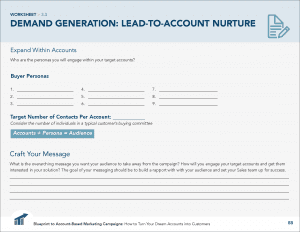Improve the effectiveness of your account-based advertising with campaigns targeting highly specific audiences.
It’s no surprise that more targeted display advertising campaigns lead to better results.
How much better?
Traditional display ads target broad audiences, typically resulting in click-through rates around 0.06%. However, account-based advertising — digital ad campaigns that target only people at your best-fit accounts — outperform traditional display.
We’ve found that the more granular the audience, the better the account-based advertising campaign performs. In fact, an analysis of our customers’ campaigns shows that Terminus account-based advertising campaigns targeting fewer than 25 accounts generate 400% more clicks than campaigns with more than 300 accounts.
That’s because a granular target audience allows you to deliver highly relevant advertising, which leads to significantly better results. Terminus is an account-based advertising solution that allows B2B marketers to create campaigns for highly segmented audiences of accounts. Because of our best-in-class B2B targeting technology, Terminus gives marketers the ability to target specific personas at these accounts with different messages.
To maximize engagement from your account-based ads, you should slice and dice your target account list as much as possible to serve the right messaging to the right audiences.
[ctt template=”1″ link=”2796N” via=”yes” ]”Ad campaigns targeting <25 accounts get 400% more clicks than campaigns with >300 accounts.”[/ctt]
10 Ways to Segment Your Advertising Campaign Audience by Account
Depending on the goal of your advertising campaign and the types of companies in your target account list, there are countless factors you can use to narrow your audience. Remember, what makes account-based advertising unique is the efficiency factor. With Terminus, you can spend your advertising budget serving up tailored messaging only to specific personas at your best-fit accounts. This is why being strategic in the way you segment your audience is a crucial step to seeing success.
To drive maximum impact from highly specific campaigns, you should segment accounts into the smallest groups that make sense. Each segment needs to be matched with messaging that is relevant to the segment. Using generic copy, creative, or content defeats the purpose of segmentation.
Let’s say you’re planning a campaign to promote an event to your Tier 1 accounts in a specific region. You could further segment that list by the various industries represented in Tier 1 and adapt the advertising copy and creative to why the event would matter for someone who works in that industry. Going a step further, you might even create a different landing page for each industry. Each increase in personalization will result in better engagement and performance.
Here are ten of the most effective ways to drill down into your target account list.
1. Tiered Accounts
If you’ve tiered your target accounts, why not segment your campaigns based on account priority? For example, you may want to put more budget towards your Tier 1 accounts and less towards Tier 2 accounts. Also, you might want to further segment your Tier 1 accounts into campaigns with specific creative, while you will keep Tier 2 in a brand awareness type campaign.
More About Target Account Tiering
Need help tiering your target accounts? Check out these resources
• How to Identify & Tier Your Target Accounts for ABM
• Get Data-Driven with Fit + Intent + Engagement
2. Intent Signals
If you use predictive technology, you can easily segment your target accounts by unique criteria such as buying intent. For example, if you have a list of accounts that are actively searching for a keyword related to your solution, you can use those keywords in targeted ads to catch their attention. If you have a list of accounts that are researching your competitor, you can serve them ads calling out reasons your solution is better.
How Attivio Used Intent Data to Triple Account Engagement

Read this ABM case study to learn how the marketing team at Attivio uses Bombora intent data to deliver keyword-specific ads to the entire buying committee at their target accounts.
3. Firmographics
Segment your audience based on firmographics such as geography, company size, industry, and annual revenue. Using firmographic characteristics is especially useful when you’re promoting an event to a local audience or tailoring your messaging to industry pain points and use cases. Creating different advertising tactics that include companies of a similar size ensures that your advertising budget is spread evenly across all accounts and each account has a chance to be served enough ad impressions.
4. Technographics
There are several different reasons you might segment your campaign audience based on technographics, or the types of technology solutions used by your target accounts. One way to leverage this information is by serving different messaging to your target accounts depending on whether or not they use a competitive solution. Of those companies that are your competitor’s customers, you can use a data provider to surface what technology they use and deliver ads that call out benefits of your solution over your competitor’s. Or, if you provide software or services that integrate with other technology providers, you can provide your target accounts with information about integrations that are most relevant to them.
How Uberflip Uses Technographic Data for Campaign Segmentation
The Uberflip team launched a campaign to engage accounts that would benefit from their integrations with marketing automation platforms.
Using Terminus, they ran three different campaigns for users of three different types of marketing automation, and they also included a generic ad for companies where they did not have that data. Unsurprisingly, the more tailored ads performed significantly better.
5. Product/Feature of Interest
By creating a field in your Salesforce CRM that indicates which product or feature is most relevant to each account, you can easily target them with messaging that fits their needs and goals. While the best way to get this information is from one-to-one conversations with prospects, that’s not always possible in the earlier stages of the sales cycle. In these scenarios, you can infer this information from page views on product pages of your website or web searches as determined using intent data providers like Bombora.
Use Website Engagement Data to Get to Know Your Accounts
With Terminus’ Account-Based Visitor ID, you can see how many unique visitors from any account came to your site, when they visited, and what pages they viewed — even if they’ve never filled out a form or otherwise identified themselves. In other words, Visitor ID turns anonymous visitors into named accounts. You can use this data to understand an account’s interests and serve them ads that align with their needs.
6. Customer Account Lists
Account-based advertising isn’t just a way to win new business. It’s also useful for expanding within your existing customer accounts, increasing product adoption, upselling and cross-selling, and providing air cover when an account’s contract renewal time comes around. Based on a customer’s use of one product, you can create tailored campaigns that illustrate the benefits of another product based on your insight of those customers.
7. Stage of the Sales Cycle
You can create an account-based advertising campaign for a specific stage of the sales cycle, or you can develop a full-funnel campaign that contains one tactic for each stage of your marketing and sales process. In this scenario, accounts automatically flow in and out of advertising tactics and receive relevant ads based on their stage in Salesforce.
8. Event Attendees
If you have a list of companies that are attending a conference or trade show, you can drop them into an account-based advertising campaign to raise awareness about your brand ahead of time. This is a great way to warm up your target accounts, as attendees are much more likely to stop by your booth if they’re already familiar with your offering. You can also use an attendee list to follow up with accounts after the event using a lead-to-account nurture campaign (see #10 below).
9. 1:1 Campaigns
If you’re doing 1:1 ABM with a shortlist of strategic accounts, you can get really creative with your digital advertising. One surefire way to catch their attention is to feature the account’s name in the ads you serve them. Further down the funnel, after your sales team has spoken with contacts at the account, you can develop messaging that speaks to their specific pain points in order to connect with additional decision-makers you haven’t yet engaged.
Localytics’ 1:1 Account-Based Advertising Campaigns
Localytics ran 1:1 Terminus campaigns using ads and content they personalized for each account. Not only did the ads include the company name, they took it a step further and created custom versions of their e-book for each company. They branded the front page of the e-book for the specific account and included personalized content based on research of each account’s successes and challenges with their current mobile strategy.
A key reason for the success of this campaign was their decision not to gate the e-books. Capturing contact data was much less important than creating a seamless experience for their target accounts.
10. Lead-to-Account Nurture Lists
A lead-to-account nurture campaign is the simplest way to combine inbound and account-based marketing. It allows B2B marketers to “bolt on” account-wide outreach to a lead-based model. When a lead from a high-quality account comes in via an inbound activity — like an event, a form fill, or a chatbot — you can use digital advertising to nurture the rest of the buying center at that company. This is effective because you can continue nurturing the lead via email while engaging additional decision-makers who are not in your database
Plan Your Lead-to-Account Nurture Campaign
Use the Lead-to-Account Nurture Campaign Planning Worksheet to map out your campaign.
2 Ways to Segment Your Advertising Campaign Audience by Persona
It doesn’t always make sense to serve your messaging to every employee at your target accounts. In many cases, specifically if you target large enterprise accounts with thousands of employees, it’s more cost-effective and impactful to drill down to the precise departments and level of seniority that have a direct impact on the purchase decision.
For each account-based advertising campaign you run, you’ll need to consider who should see which ads. For more relevant targeting, you can break each campaign down into multiple advertising tactics and serve different messaging to different stakeholders.
There are two ways to approach segmentation within an account.
1. Departments
Stakeholders within different departments approach the research and buying process differently. For example, CFOs care about the financial impact of the purchase, while the end users care about features and functionality. With account-based digital advertising, you have the ability to engage each department within an account with messaging that matters to them. Delivering the right message to the right stakeholders can significantly impact the length of the sales cycle by removing blockers that could stall a deal. In fact, SOASTA was able to use this strategy to cut their sales cycle length by 40%.
2. Seniority
You can also choose to create a segment of manager-level roles and above at your target accounts to hone in on the people with the most decision-making power. For example, if you sell HR software, you can set up two advertising tactics: one targeting the entire HR department, and another targeting all senior decision-makers at your target account.
Engage the Right People with Account-Based Advertising
Terminus allows B2B marketing teams to serve highly relevant messages to the right people at the right companies. By segmenting your list of target accounts, you can ensure your buyers are getting consistent, relevant information throughout the entire sales process and beyond.
The bottom line: the more you can segment your account list and personalize your display ads, the more effective your campaigns will be.
To learn more about running account-based advertising campaigns with Terminus, schedule a demo with our ABM experts.
If you’re a Terminus customer and have questions about building and segmenting your audience, contact your customer success manager or email [email protected].
